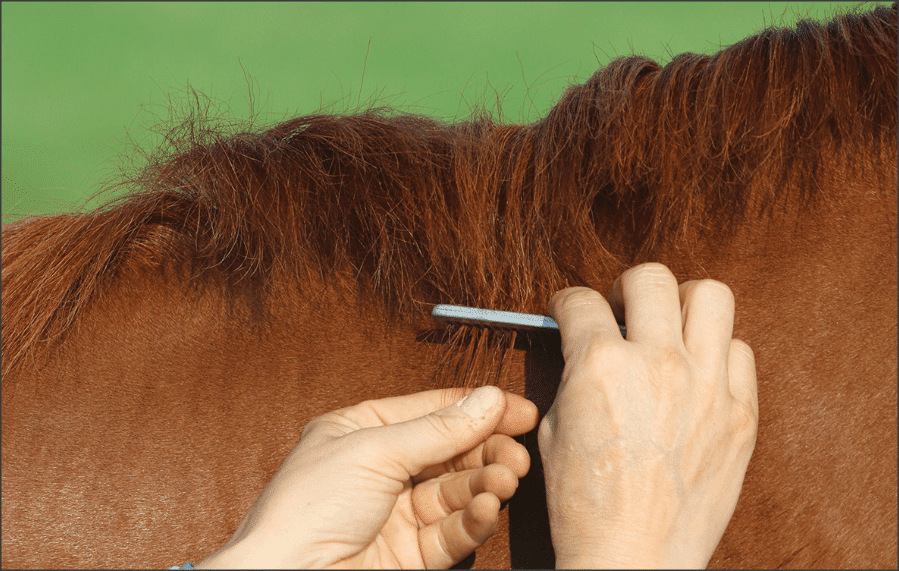Table of Contents
Clenbuterol is a beta-2 agonist used to treat respiratory issues in animals. However, it’s often misused in racing for its performance-enhancing and muscle-building effects. Because of this, monitoring clenbuterol use in horses is critical, especially in competitive equine sports. Which is why we’re discussing the determination of Clenbuterol in Horse Hair by Gas Chromatography.
Hair analysis is emerging as a reliable long-term detection method. Hair can retain clenbuterol traces for weeks or months, unlike blood or urine. Researchers and veterinarians often use gas chromatography (GC) to detect it precisely.
This blog explores how gas chromatography determines clenbuterol in horse hair, its preference, and what makes the method reliable and essential for equine doping control.
Background Information
Clenbuterol: Chemical Properties, Physiological Effects, and Detection Challenges
Chemical Properties of Clenbuterol:
- Clenbuterol is a sympathomimetic drug that belongs to the class of β2-adrenergic agonists. It is primarily used for its bronchodilator effects, treating conditions like asthma or chronic obstructive pulmonary disease (COPD). Its chemical formula is C12H18Cl2N2O, and it also has a molecular weight of approximately 277.19 g/mol.
- Clenbuterol is often administered orally, but it can also be used as an injectable. It has a long half-life (around 36-48 hours), making it detectable in biological samples for extended periods.
Physiological Effects of Clenbuterol:
- Bronchodilation: Clenbuterol works by relaxing smooth muscle in the airways, making it easier for horses (and other animals) to breathe. It is commonly used in veterinary medicine to treat respiratory disorders such as heaves or asthma in horses.
- Performance Enhancement: In addition to its respiratory effects, Clenbuterol is sometimes abused as a performance-enhancing drug (PED) because of its ability to increase muscle mass and reduce fat. This anabolic effect makes it a target for detection in anti-doping testing.
- Side Effects: At higher doses, Clenbuterol can also cause tachycardia (rapid heart rate), tremors, and nervousness. These side effects are particularly concerning in athletes as they could lead to serious health issues or be indicative of drug misuse.
Detection Challenges:
- Clenbuterol is also often administered in low doses and may be present in biological samples for days or weeks, depending on the administration method and dose.
- Moreover, detecting Clenbuterol in complex matrices like hair can be challenging because hair samples contain multiple components that can interfere with the analysis. Additionally, Clenbuterol is lipophilic (fat-soluble), which means it can accumulate in hair follicles and remain detectable long after the drug has cleared from other bodily fluids like urine or blood.
- The detection of Clenbuterol also requires highly sensitive and specific techniques to avoid false positives and ensure accuracy.
Why Analyze Horse Hair for Clenbuterol?
Traditional testing relies on blood or urine samples showing recent clenbuterol use. These methods work for short detection windows. However, clenbuterol can be cleared from the bloodstream quickly, leaving no trace after a few days.
Hair, on the other hand, serves as a biological record. Once clenbuterol enters the bloodstream, small amounts incorporate into the growing hair shaft. Over time, these deposits accumulate and remain unchanged unless the hair is cut or shed.
Key Advantages of Hair Testing:
- Long detection window
- Non-invasive sample collection
- Easy storage and transport
- Tamper-resistant sample integrity
Because of these advantages, horse hair analysis has become a trusted tool in research and doping investigations.
What Is Gas Chromatography (GC)?
Furthermore, gas chromatography is an analytical technique for separating and analyzing compounds that can be vaporized without decomposition. It’s widely used in forensics, drug testing, and pharmaceutical analysis.
In clenbuterol testing, GC also allows detection of trace amounts in complex biological matrices like hair. It becomes even more sensitive and specific when coupled with a mass spectrometer (GC-MS).
Step-by-Step: Detecting Clenbuterol in Horse Hair Using GC
Here’s a step-by-step guide for detecting clenbuterol in horse hair using Gas Chromatography (GC), typically paired with mass spectrometry (GC-MS) for sensitivity and specificity:
1. Sample Collection
The process also begins by collecting mane or tail hair from the horse. Tail hair is often preferred due to its slower growth, which creates more distinct time windows.
- Hair is cut close to the skin
- At least 50–100 mg is typically required
- Clean, sealed bags prevent contamination
2. Sample Preparation
Secondly, hair contains oils, sweat, and environmental contaminants. Therefore, cleaning the hair thoroughly is critical.
- Hair is washed using organic solvents (e.g., methanol)
- It’s dried and then cut into small segments or pulverized
- Pulverizing ensures a uniform sample
3. Extraction of Clenbuterol
Furthermore, to isolate clenbuterol from the hair:
- The sample is soaked in a solvent mixture
- Often, acidified methanol or buffer solutions are used
- The solution is then vortexed, incubated, and centrifuged
- The supernatant (liquid portion) is collected for analysis
Further purification (e.g., solid-phase extraction) is sometimes done to reduce background noise.
4. Derivatization (Optional)
Clenbuterol may undergo derivatization before GC analysis. This step enhances volatility and improves detection. Reagents like BSTFA (N, O-bis(trimethylsilyl)trifluoroacetamide) are commonly used.
5. GC or GC-MS Analysis
The processed sample is injected into a gas chromatograph:
- An inert carrier gas (like helium) moves the sample through a column
- As compounds travel through the column, they separate based on boiling point and polarity
- Each component exits the column at a different time — this is the retention time
If coupled with mass spectrometry (GC-MS), the system further breaks down compounds into ion fragments, offering precise identification and quantification.
6. Data Interpretation
The final step involves analyzing the chromatogram:
- Peaks represent different compounds
- Clenbuterol has a distinct retention time and ion profile
- By comparing against known standards, the presence and amount of clenbuterol are confirmed
Quantification uses calibration curves, ensuring accuracy even at very low concentrations (ng/mg range).
Challenges and Considerations
Despite its effectiveness, GC analysis of clenbuterol in hair isn’t without challenges.
1. External Contamination
Clenbuterol can stick to the hair surface through sweat or exposure. Therefore, proper washing and control of samples are vital.
2. Variable Hair Growth Rates
Factors like age, nutrition, and health affect hair growth. That means the timeline for clenbuterol intake can vary, making interpretation more complex.
3. Equipment Sensitivity
GC-MS equipment must be properly calibrated and maintained. Even small instrument errors can affect results.
4. Legal and Ethical Implications
Positive tests can lead to disciplinary action, disqualification, or bans. Thus, labs must ensure sample integrity and accurate documentation at every stage.
Why This Method Matters in Equine Sports
The horse racing and equestrian industries face ongoing scrutiny over performance-enhancing drug use. Testing for clenbuterol through hair samples analyzed by gas chromatography is a powerful deterrent.
It allows organizations to:
- Enforce fair competition
- Track long-term substance use
- Monitor recovery from legitimate treatments
- Ensure animal welfare
With reliable testing, governing bodies can maintain credibility and trust in the sport.
Final Thoughts
Determining clenbuterol in horse hair using gas chromatography is a proven, accurate, and reliable method. It helps uncover long-term substance use in horses, offering an advantage over traditional blood or urine testing.
Although it requires precise lab work, proper calibration, and careful interpretation, the method remains a gold standard for equine doping control. With growing awareness and improved testing tools, the industry is moving closer to fairer and cleaner competition.








